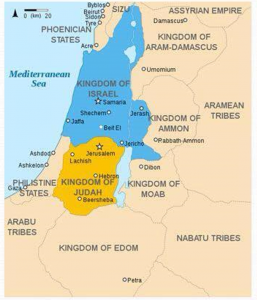
“Behold, I will tear the kingdom out of the hand of Solomon and give ten tribes to you.”
1 Kings 11:31
It is a big topic of conversation among scholars, apologists, Bible history buffs, and many others—where are the lost tribes of Israel? Do they even exist anymore? Like much in the Bible, we must review Israel’s history to understand what became of these tribes and why some people consider them lost.
We begin in 1 Kings 11.
The Twelve Tribes of Israel
King Solomon had grown old and was drifting from the Lord. Though he still sought to serve God, he was doing a very poor job of it. Solomon kept many wives and concubines and worshipped their false idols, such as Ashtoreth. Finally, the Lord had enough and separated Israel into two nations. He gave the Southern Kingdom of Judah to Rehoboam, Solomon’s son, and the Northern Kingdom to Jeroboam, who was Solomon’s administrator over the labor force.
One day, a little-known prophet named Ahijah went to Jeroboam to tell him a prophecy the Lord had given him.
“Then Ahijah took hold of the new garment that was on him and tore it into twelve pieces. And he said to Jeroboam, ‘Take for yourself ten pieces, for thus says the LORD, the God of Israel: ‘Behold, I will tear the kingdom out of the hand of Solomon and will give ten tribes to you (but he shall have one tribe for the sake of My servant David, and for the sake of Jerusalem, the city which I have chosen out of all the tribes of Israel).’’” 1 Kings 11:30-32 NKJ
The prophecy came true, and God placed ten of the twelve tribes of Jacob in the Northern Kingdom called Israel with Jeroboam as ruler. These tribes are Reuben, Simeon, Dan, Naphtali, Gad, Asher, Issachar, Zebulun, and Joseph, whose tribe was divided into Ephraim and Manasseh. The kingdom spanned the area from Dan near the Lebanon mountains southward to Beersheba, south of Jerusalem, and included Transjordan.
The tribes in the Southern Kingdom (collectively known simply as Judah) were Judah, Simeon, and most of Benjamin. The Levites were not included as a tribe because they were not landowners, though Ahijah clearly states God would keep the Levites, the priestly tribe, in Jerusalem “for the sake of My servant David.”

Kingdom Attacks
Neither Jeroboam nor his successors in the Northern Kingdom followed God. Eventually, in 722 B.C., God allowed the Assyrians to invade the Northern Kingdom, take the people captive (2 Kings 17:6), and assimilate them.
Some Jews remained in Israel, however. They married people sent by the Assyrian king to settle Samaria, the capital of the Northern Kingdom, where further assimilation occurred.
With the Northern Kingdom under Assyrian control, King Nebuchadnezzar of Babylon invaded the Southern Kingdom, taking most of its population captive. Most of the people slowly lost their identity, but many remained connected to their Jewish heritage. By the time King Cyrus allowed the people to return to Jerusalem, the Northern Kingdom was all but gone, causing many academics to claim the Israelites of today descended mainly from the tribes of Judah.
Varying Theologies
Many people have tried to find the ten tribes based on the “theologies of ingathering.” They claimed the tribes relocated to wide-scattered places such as Arabia, India, Nigeria, Ethiopia, Pakistan, Afghanistan, and even as far away as China and Japan.
The belief certain tribes are in England was purported by a former rabbi in Amsterdam who dedicated his book, The Hope of Israel, in 1650 A.D. to the British Parliament. With support from English theologians, his ideas and claims became known as the heretical “British Israelism.”
In support of British Israelism in 1794, a radical Calvinist named Richard Brothers declared himself a prophet of the lost tribes in his writings from an insane asylum in London. His current situation did not deter people from following him and creating a doctrine called Anglo-Israelism. This ultra-nationalist theology claims the British Isles was the home of the lost tribes.
Anglo-Israelism theology never developed into a comprehensible scripture-based theology. But many people eventually came to accept and believe that some of the lost tribes were either in England or the United States, which is why some claim the Native American tribes are a part of the lost tribes.
The theology of any lost tribes inhabiting North America eventually became part of a false, heretical scripture called The Book of Mormonism. They base their belief on their prophet Nephi who promises, “But now I go unto the Father, and also to show myself unto the lost tribes of Israel, for they are not lost unto the Father, for he knoweth whither he hath taken them (3 Nephi 17:4).”
Jewish But Not Jewish
In 1989, Tudor Parfitt of the University of London’s School of Oriental and African Studies wrote The Lost Tribes of Israel. Parfitt attributes the claims of tribes scattered around the world to cultural labeling.
Parfitt argues many of these claims stem from a sense of persecution and not any historical records. The people may have claimed to be Jews and engaged in Jewish practices, but they were not true descendants of Israel. Parfitt contends persecuted minorities were derogatorily labeled as Jewish, accusing them of evil. The label somehow stuck, fueling anti-Semitism.
Many scholars and academics support Parfitt’s thesis. However, descendants of the Northern Kingdom may indeed have spread worldwide, perhaps not even realizing their heritage.

Scripture Supports the Tribes
With some Jews dispersed and others intermarrying, the ten tribes were considered “lost” or “diluted” to history. But while the events are actual, the idea of any lost tribes is based strictly on assumptions and old Jewish traditions. None of it is biblical. The truth is God knows exactly where they are, and the Scriptures clearly reveal the evidence.
The prophet Isaiah prophesied the day God calls the tribes to Himself.
“So it shall be in that day: The great trumpet will be blown. They will come, who are about to perish in the land of Assyria, and they who are outcasts in the land of Egypt and shall worship the LORD in the holy mount at Jerusalem.” Isaiah 27:13 NKJ
The New Testament also reveals several pieces of evidence that the tribes are not lost.
When Joseph and Mary took their newborn baby Jesus to the Temple to be dedicated and circumcised, they ran into a prophetess named Anna. Luke 2:36 clearly states that Anna was from the tribe of Asher, a Northern Kingdom tribe.
Similarly, the apostle Paul knew he was from the tribe of Benjamin (Romans 11:1). He also acknowledged the tribes’ existence in Acts 26. Note the present tense of Paul’s words.
“And now I stand and am judged for the hope of the promise made by God to our fathers. To this promise our twelve tribes, earnestly serving God night and day, hope to attain.” Acts 26:6-7
Luke 1:5 tells us the priest Zacharias was of the division of Abijah, a Levite High Priest, and his wife Elizabeth was a daughter of Aaron, another Levite High Priest. And so, by descent, their son John the Baptist was also a Levite.
The apostle James addresses his letter to the “twelve tribes which are scattered abroad” (James 1:1).
Jesus Himself declares the lost tribes still exist.
“And I bestow upon you a kingdom just as My Father bestowed one upon Me, that you may eat and drink at My table in My kingdom and sit on thrones judging the twelve tribes of Israel.” Luke 22:29-30
And Revelation 7:4-8 says God will call forth 144,000 witnesses from all twelve original tribes, 12,000 from each tribe, in the last days.
The Bible supplies more than enough evidence that the tribes of Israel are not at all lost. They may be scattered, but they still exist. And one day, they will gather again in the coming Messianic Kingdom.
